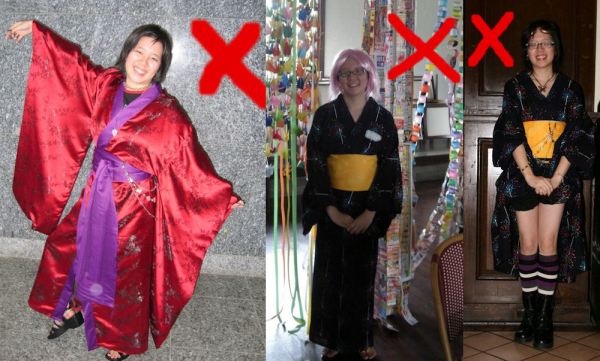Or What I Mean by “Don’t Put on Awful ‘Geisha’ Make-up”
My most popular post, “Why I Won’t Tell You Where to Buy Yukata Anymore”, happens to be a controversial one. It’s also easily misunderstood. Two comments have misread one particular phrase that I added as an after-thought: “I can’t prevent anyone from wearing a yukata, but if you do, please don’t put on awful ‘geisha’ make-up (that’s the equivalent of blackface)”. Note the quotations around “geisha”. What I’m talking about is a form of yellowface. Although I admit to being erroneous in equating it with blackface, as the history of oppression differs between Asians and blacks (and it is by no means equal), yellowface is still hurts Asians today.
Racebending has a great article on the history of yellowface in film. Unfortunately the photos don’t appear, but Buzzfeed recently release a video that features some of the examples, along with reactions from East Asians. It pretty much sums up how the sight of yellowface makes us feel.
While we can all agree that Mr. Yunioshi in Breakfast at Tiffany‘s is terrible and Mickey Rooney has apologized for the role, the film remains a classic. Furthermore, other instances of yellowface have been overlooked in actors’ careers and in some cases, have been awarded with Oscars. The lack of discussion erases the struggles of Asians.
Even if the characters are not malicious stereotypes, the damage is still present. First, not every Asian has upward slanted eyes, heavy monolids, and high cheekbones. To lump us all into one group, one image makes us two-dimensional caricatures rather than fully developed characters who aren’t defined by physical traits. Secondly, every non-Asian in make-up deprives an Asian actor of a job and decreases the amount of proper representation. How many people remember the silent film star Sessue Hayakawa? He actually was able to experience success in Hollywood and star opposite white actresses, but then anti-Japanese sentiments and the Motion Picture Production Code, which forbade the depiction of interracial relationships, caused his career to decline. Even at the height of his popularity, he still struggled to be the romantic lead, something his white counterparts never experienced.

Spoiler alert: Sessue Hayakawa doesn’t get the white girl. Also, it’s worth noting that he portrayed other races in his early career, but two wrongs do not make a right (hear that Cloud Atlas defenders?) and it definitely did not benefit him in the future. Photo from Mirelle Balin – Femme Fatale.
Hayakawa’s struggles reveal why movies like Sayonara and more recently Cloud Atlas should also be accountable despite having Asian actresses. Neither cast Asian men in any of their roles, perpetuating the idea that real Asian men do not have the passion or machismo that it takes to be romantic leads (having an Asian male does not count—real world actions speak louder than words on a script) . The inclusion of Asian actresses at the expense of their male counterparts highlights are another problem: fetishization. Stereotypes have cast Asian women as either a Madame Butterfly or a Dragon Lady, and despite being polar opposites, they both serve as sexual objects.
This is where the bad “geisha” make-up comes in. Even if it is an inspired make-up job rather than blatant yellowface, it still has the same harmful effects. Madonna and Kylie Minogue have utilized it to re-invent themselves, which is often musical industry code for making themselves edgier and sexier. Their fetishization of geisha is reinforced by their modified kimonos and suggestive imagery. Minogue even goes so far as calling that segment “Naughty Manga Girl”.
 From The Daily Telegraph
From The Daily Telegraph
More recently, Katy Perry has come under fire for her randomly Orientalist performance at the AMAs. Although she doesn’t do the make-up, her back-up dancers are made to appear more “Asian”. This is another example of non-Asians taking away Asian roles. In all these cases, the singers are using the image of a geisha for personal gain.
There’s also the implication that geisha are ubiquitous when the make-up is taken out of context. That is what I was getting at in my original post. It does not belong with an informal yukata, nor automatically express an “appreciation” for Japanese culture. Instead, it promotes misunderstanding and disregards the years of training that geisha go through. It also often looks more like what one would see in Chinese opera, which again lumps Asians together as this large foreign group rather than individual traditions.
I’m not saying non-Japanese people can never wear geisha make-up. Liza Dalby was invited to become a geisha (note that she did not insist herself). Visitors in Kyoto can purchase a service that allows them to dress up as maiko and take photos. This directly benefits Japanese businesses. Cosplaying a character who is a geisha may be a little contentious, but if you keep your natural features with the make-up, you’ll piss off fewer Asians who endured a lifetime of being mocked for their eye shape or called a geisha when they’re in a different traditional outfit. Just think about whether you are contributing to negative stereotypes and remember that movies continue to feature yellowface and companies still sell “Asian eyelids”.
Listening to: “Busy Doing Nothing” by Crystal Kay















